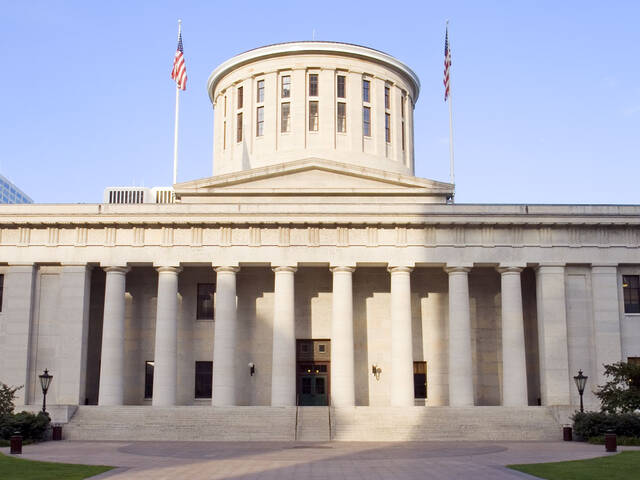House-passed budget proposes significant cuts to H2Ohio program, and more news
In the House-passed version of House Bill 96, the state operating budget, the H2Ohio program would see its funding decrease from $229.5 million over the current biennium to $149.9 million over the upcoming biennium, a 35% funding reduction. Along with the proposed cuts in funding, the House also added language that would prohibit any H2Ohio funds from being used to purchase land or to place land in a conservation easement.
The budget cuts will be distributed evenly throughout the three agencies that administer H2Ohio funds. The Department of Agriculture, the Ohio Environmental Protection Agency, and the Department of Natural Resources would each be cut roughly 55% from SFY 2025 to SFY 2026. A small appropriation to the Lake Erie Commission for H2Ohio is flat-funded.
Department of Agriculture – Funding for H2Ohio to the Department of Agriculture is cut from
$60.7 million in SFY 2025 to $33.7 million in each fiscal year. The Department of Agriculture’s H2Ohio funds are mainly used for the reduction of excess nutrients within the Western Lake Erie Basin.
Funding through the Department is also used to incentivize best management practices for farmers in the northwest region of the state. Roughly 2,600 agreements between farmers and the Department have been signed since the program’s inception. This has equated to
nearly two million acres of farmland being designated as following the nutrient management plans, or nearly 36 % of all farmlands within the Western Lake Erie Basin.
Department of Natural Resources – Funding for H2Ohio to the Department of Natural Resources is cut from $46.6 million in SFY 2025 to $26.2 in each fiscal year. The funding the Department receives has been largely used to create wetland projects throughout the state. This project has made H2Ohio funding accessible to all parts of the state, which had historically focused mainly on Western Lake Erie Basin issues.
The Department has completed and is in progress to complete over 200 wetland projects throughout the state to date. Wetland projects have been a way to assist in lowering the
likelihood of harmful algal blooms. A wetland will slow the flow of water and allow nutrients to settle, which can help reduce nutrient loading into larger waterways. The slowing down of the nutrients causes the nutrients within the soil to fuel ecosystems and native plants instead of flowing downstream.
The language in HB 96 will have a harmful effect on this program as H2Ohio funds will no longer be able to be used for conservation easements or to purchase land.
Ohio Environmental Protection Agency – Funding for H2Ohio to the Ohio Environmental Protection Agency (OEPA) is cut from $27.5 million in SFY 2025 to $14.9 million in each fiscal year. The funding OEPA receives is used to focus on addressing failing home sewage treatment systems, replacing lead service lines, and funding water and sewer infrastructure projects. Recently $1.9 million was used across 22 counties for equipment and storage facility upgrades to help reduce the overapplication of de-icing materials on Ohio’s roads, which ultimately helps the health of Ohio’s waterways.
US Supreme Court lifts stay, allows signature gathering for ballot measure to repeal qualified immunity
On Tuesday, the full US Supreme Court repealed an order that prevented advocates in Ohio
from collecting signatures to place a constitutional amendment titled “Protecting Ohioans’
Constitutional Rights” on the ballot. The amendment aims to remove all qualified immunity protections from government workers if they are civilly sued for conduct that occurred during the exercise of their official job duties.
The group gathered the required 1,000 signatures eight separate times to submit language to the Attorney General for his approval. Attorney General Yost had rejected their ballot language each time stating that it was misleading to Ohio voters. The ballot group challenged the Attorney General’s ruling in federal court in March 2024.
The ballot group was ultimately successful in federal court, which ruled that Ohio’s law, and the Attorney General’s interpretation of the law, placed a content-based restriction on
voters’ speech and likely violated the First Amendment. Attorney General Yost appealed this decision to the US Supreme Court and asked them to pause signature collection for the ballot group while the Court heard the appeal. The US Supreme Court initially granted the stay, but its ruling this week in rejecting the appeal ended it.
This ruling will ultimately increase the chance that the constitutional amendment will appear on the ballot in the future. The removal of qualified immunity will expose all county elected officials and county workers to civil lawsuits. This would significantly increase insurance costs and likely shrink the labor pool for county employment.
CCAO is working with the Ohio Prosecuting Attorneys Association, the Buckeye State Sheriffs Association, and other local government and law enforcement groups to monitor the issue and potentially oppose the amendment if it is placed on the ballot.
Legislative Activity
Introduction of Bills
The following bill(s) that may be of interest to counties were introduced this week:
– Senate Bill 179 (Senator Terry Johnson): To verify the veteran status of imprisoned individuals and individuals facing imprisonment.
– Senate Bill 180 (Senator Terry Johnson): To prohibit the purchase of small unmanned aircraft systems manufactured or assembled by a covered foreign entity.
– Senate Bill 181 (Senator Shane Wilkin): To establish regulations for the underground mining of limestone and dolomite and to increase certain severance tax rates.
Subscribe to The Clermont Sun today!
https://www.clermontsun.com/subscribe

